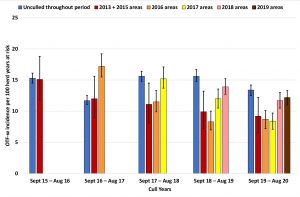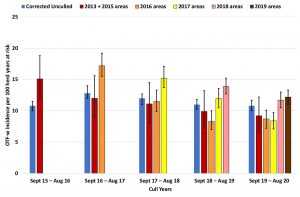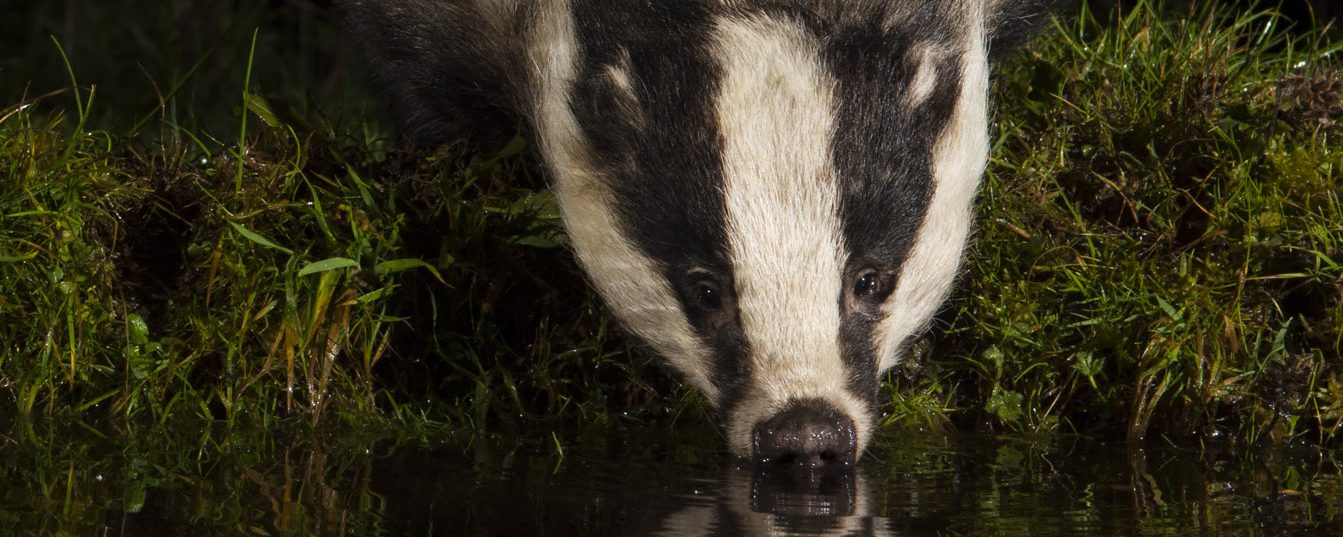

In March 2022 the Chief Veterinary Officer (CVO) Christine Middlemiss & Chief Scientific Advisor (CSA) Gideon Henderson joined Defra Media Centre in attacking a peer-reviewed, freshly published scientific paper on bovine TB control (Langton et al.), stating that they thought it was flawed, and had ‘inappropriate’ analysis, see here.
The graph the CVO & CSA produced (top right) looked odd, and the authors of the original paper immediately suspected an error in the data, and wrote to Defra with an enquiry to this effect. In addition, much of their written rebuttal seemed invalid. Further, the CVO wrote a personal blog highlighting her criticisms of the new paper. The blog then received a number of posted comments from external observers and academics which reiterated the papers’ authors’ concerns about potential errors in Defra’s analysis and incorrect conclusions. A response to the CVO & CSA from the authors of the paper was printed in Vet Record on 02 April, see here.
It took more than six weeks before Defra admitted that it had got it wrong and published a new graph of data (above, bottom right). But they maintained that this did not change their overall conclusions about the new paper; basically that it was ‘wrong’. They did not respond to the rebuttal arguments that the authors put forward in the 02 April issue of the journal Veterinary Record. On this there is still strange silence.
The authors of the paper had a further letter published in Vet Record on May 21st responding to Defra’s admission of data errors and their replacement graph. You can read this here.
This week, CVO Christine Middlemiss made a small adjustment to her blog, but did not change her faulty graph. She added some wording to the following paragraph (in bold).
|
“Our analysis indicates a clear reduction in OTFw cattle breakdowns, relative to unculled areas, in culled areas from cull year 2 onwards (Fig 1). For example, TB incidence in the areas where culling started in 2016 has dropped from 17.2 OTFw breakdowns per 100 herd years at risk in 2016/17, to 8.7 in 2019/20. Similarly in the areas where culling started in 2017 it has dropped from 15.3 in 2017/18 to 8.4 in 2019/20. In contrast, in the parts of the high-risk area (HRA) where no culling took place, incidence has only fluctuated slightly from year to year, from 10.9 in 2015/16 rising to 12.8 in 2016/17 before returning to 10.9 in 2019/20.” |
It is a shame that the CVO does not seem to have grasped that the first bar in the graph represents the first year data after culling and not pre-cull incidence. Incidence levels before culling began are missed off, and these better shows the pattern of change in the first two years that they focus on.
The CVO & CSA’s main criticism of the new paper is that (they imply) bTB does not come down enough in the first two years for those years to be grouped with later years of culling. Looking at their graph, this is clearly not the case and the CVO and CSA’s position is a paradox and nonsense. There is a drop in culled and unculled areas if you examine all the culled and unculled data, and not just a sample of unculled (never-culled) area. The steady decline in incidence, as shown in the Langton, Jones and McGill paper, is attributable to cattle testing and movement control measures. Defra’s attempt to show otherwise falls at the first hurdle. It is something Middlemiss and Henderson seem reluctant to address. It is understood that Defra intend to ignore their own faulty response, and endorse an APHA study at a disease conference in July in Canada as justification to carry on culling in September.
Christine Middlesmiss doubled down on her position in an interview on Farming Today on 26th May (the focus of which was Defra’s badger vaccination licensing scheme), using very strong language and stating that in the Langton, Jones and McGill paper, “the whole methodology was wrong and so the conclusion was wrong.” Again, she claimed that the authors had “not used a robust methodology to examine and assess it and therefore the conclusions are wrong, they’re not scientifically valid.”
This is a bold claim about a rigorously peer reviewed paper in a leading scientific journal, and one that it could be said she should be able to clearly and concisely articulate in a debate, or at least to the authors. It is not good enough for the CVO to just claim, as she did in her interview, that “it is complex“.
Further she said “we believe that culling is effective“, apparently relying on faith rather than understanding of published science. She must be able to explain her reasoning for dismissal of peer reviewed science. She also said that “It’s not absolutely my decision to release it [the data]“, implying political interference? The authors are still waiting for a response to their April invitation to discuss the CVO’s criticism with her.
You can listen to the CVO’s interview on Farming Today, available here.

The CVO & the CSA must look again and accept the findings of the new robust peer-reviewed research. Prevailing science shows the current badger culling policy to have failed, with no detectable impact from it on the incidence of bovine TB in cattle herds in the High Risk Area. The 29 Supplementary Badger Culling licences authorised this Wednesday were issued on the back of a government veterinary service in denial.
You can donate to our campaign legal fund below:
Donate
Thank You.

